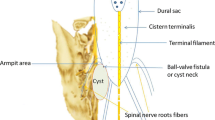Abstract
Purpose
We have discussed the importance of sacrococcygeal sinus angle (SSA), which is a new anatomical landmark in the surgery of presacral lesions. Because of its anatomical structure, the sacrum limits the surgical exposure like a compact barrier for the posterior surgical approach. The main aim of this paper is to explain the anatomical description and clinical importance of SSA in the surgery of presacral lesions.
Methods
Three groups were designated, consisting of ten patients in each group, as early childhood (group 1), late childhood (group 2) and adulthood (group 3). Patients were selected randomly. The degree of SSA measurement was performed between the line tangent to the anterior margin of the first sacral vertebra and the line from the promontorium to the tip of the coccyx. The measurement of SSA was performed on patients’ lumbosacral magnetic resonance images. When the SSA forms a triangle via a parallel line starting from the inferior tip of the sacrum and running parallel to the ground, the area of the triangle also covers the field of view of the presacral region. In addition, the sacral region needed to be resected for maximum exposure is also within this area.
Results
The mean SSA was measured to be 53.9 ± 11.4° in group 1, 77.8 ± 11.2° in group 2 and 74.5 ± 12.5° in group 3. Intergroup comparisons revealed a significant difference between group 1 and the other two groups statistically. It was found that the SSA was 20° less in group 1 as compared to the other age groups (p = 0.0005). The area of a triangle is calculated using the sine area formula, and according to this formula the area of a triangle increases when the degree of the angle increases, thus comprising larger part of the sacrum. This condition requires more and wide sacral resection to obtain maximum exposure in the presacral zone.
Conclusions
We have observed that the SSA is significantly smaller during early childhood compared with the other age groups. This feature provides an anatomical superiority in this age group for the posterior approach in the surgical treatment of presacral masses.


Similar content being viewed by others
References
Buchs N, Taylor S, Roche B (2007) The posterior approach for low retrorectal tumors in adults. Int J Colorectal Dis 22:381–385
Canelles E, Roig JV, Cantos M, Garcia Armengol J, Barreiro E, Villalba FL, Ruiz MD, Pla V (2009) Presacral tumors. Analysis of 20 surgically treated patients. Cir Esp 85:371–377
Fan M, Peng Q, Wang XY, Meng QF, Li ZP (2009) CT and MRI manifestations of pediatric presacral tumors. Chin J Cancer 28:1–6
Gagner M, Nieuwenhuis DH, Bardaro SJ, Consten EC (2008) Endoscopic perineal approach to the presacral space: a feasibility study. Surg Endosc 22:1987–1991
Guillem P, Ernst O, Herjean M, Triboulet JP (2001) Retrorectal tumors: an assessment of the abdominal approach. Ann Chir 126:138–142
Kang J, Hur H, Min BS, Lee KY, Kim NK (2012) Robotic coloanal anastomosis with or without intersphincteric resection for low rectal cancer: starting with the perianal approach followed by robotic procedure. Ann Surg Oncol 19:154–155
Kaplan M, Akgun B, Kazez A, Ucler N, Cobanoglu B (2010) Posterior approach for sacrococcygeal posterior meningocele with anterior large mature cystic teratoma. Cent Eur Neurosurg 71:221–223
Kaplan M, Ozveren MF (2007) Sacral window for the surgery of L5 neurofibroma: a technical note. Turk Neurosurg 17:232–234
Kocaoglu M, Frush DP (2006) Pediatric presacral masses. Radiographics 26:833–857
Lev-Chelouche D, Gutman M, Goldman G, Even-Sapir E, Meller I, Issakov J, Klausner JM, Rabau M (2003) Presacral tumors: a practical classification and treatment of a unique and heterogenous group of diseases. Surgery 133:473–478
Li D, Guo W, Tang X, Ji T, Zhang Y (2011) Surgical classification of different types of en bloc resection for primary malignant sacral tumors. Eur Spine J 20:2275–2281
Localio SA, Eng K, Ranson JH (1980) Abdominosacral approach for retrorectal tumors. Ann Surg 91:555–560
Wei G, Xiaodong T, Yi Y, Ji T (2009) Strategy of surgical treatment of sacral neurogenic tumors. Spine 34:2587–2592
Yang CC, Chen HC, Chen CM (2007) Endoscopic resection of a presacral schwannoma. J Neurosurg Spine 7:86–89
Zileli M, Hoscoskun C, Brastianos P, Sabah D (2003) Surgical treatment of primary sacral tumors: complications associated with sacrectomy. Neurosurg Focus 15:15
Conflict of interest
None.
Author information
Authors and Affiliations
Corresponding author
Rights and permissions
About this article
Cite this article
Kaplan, M., Ozturk, S., Cakin, H. et al. Sacrococcygeal sinus angle: as a new anatomic landmark for the posterior approach of presacral lesions. Eur Spine J 23, 337–340 (2014). https://doi.org/10.1007/s00586-013-2830-5
Received:
Revised:
Accepted:
Published:
Issue Date:
DOI: https://doi.org/10.1007/s00586-013-2830-5




